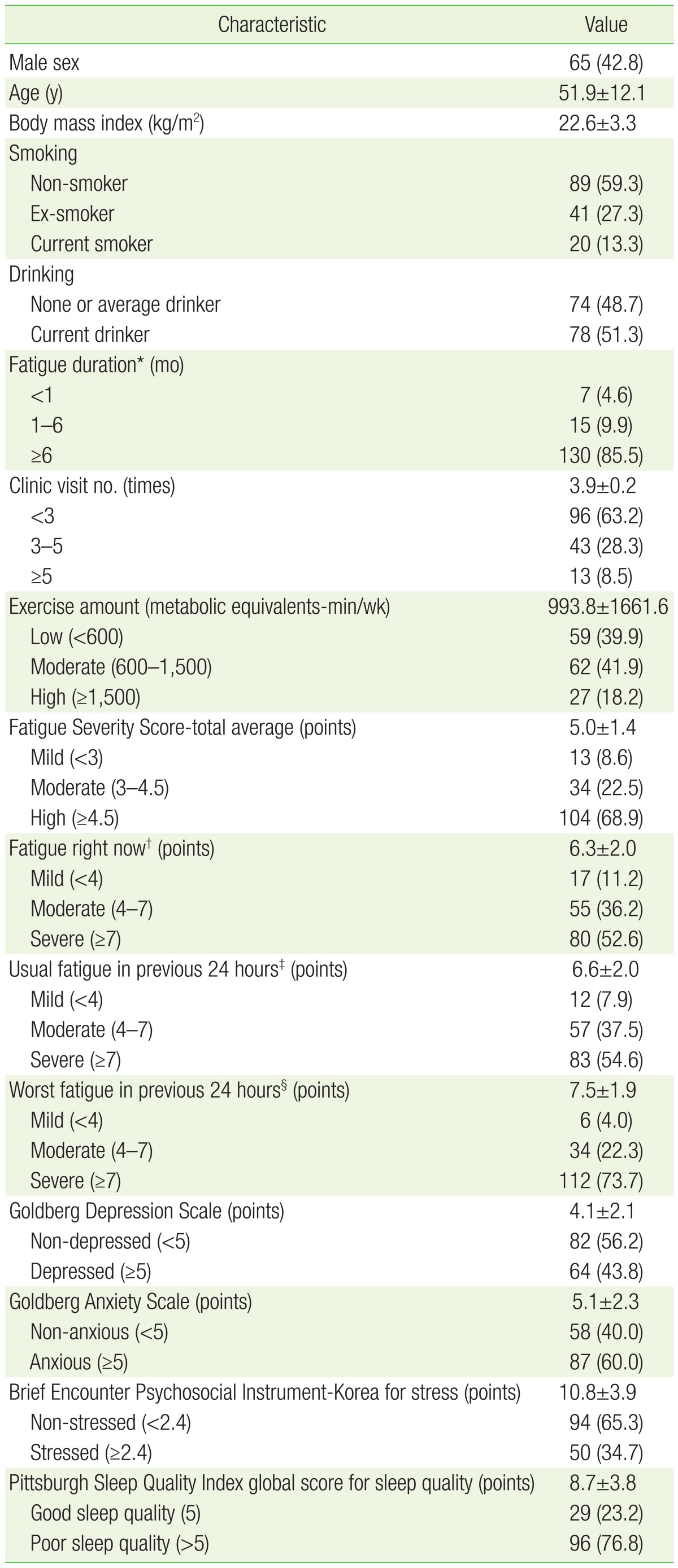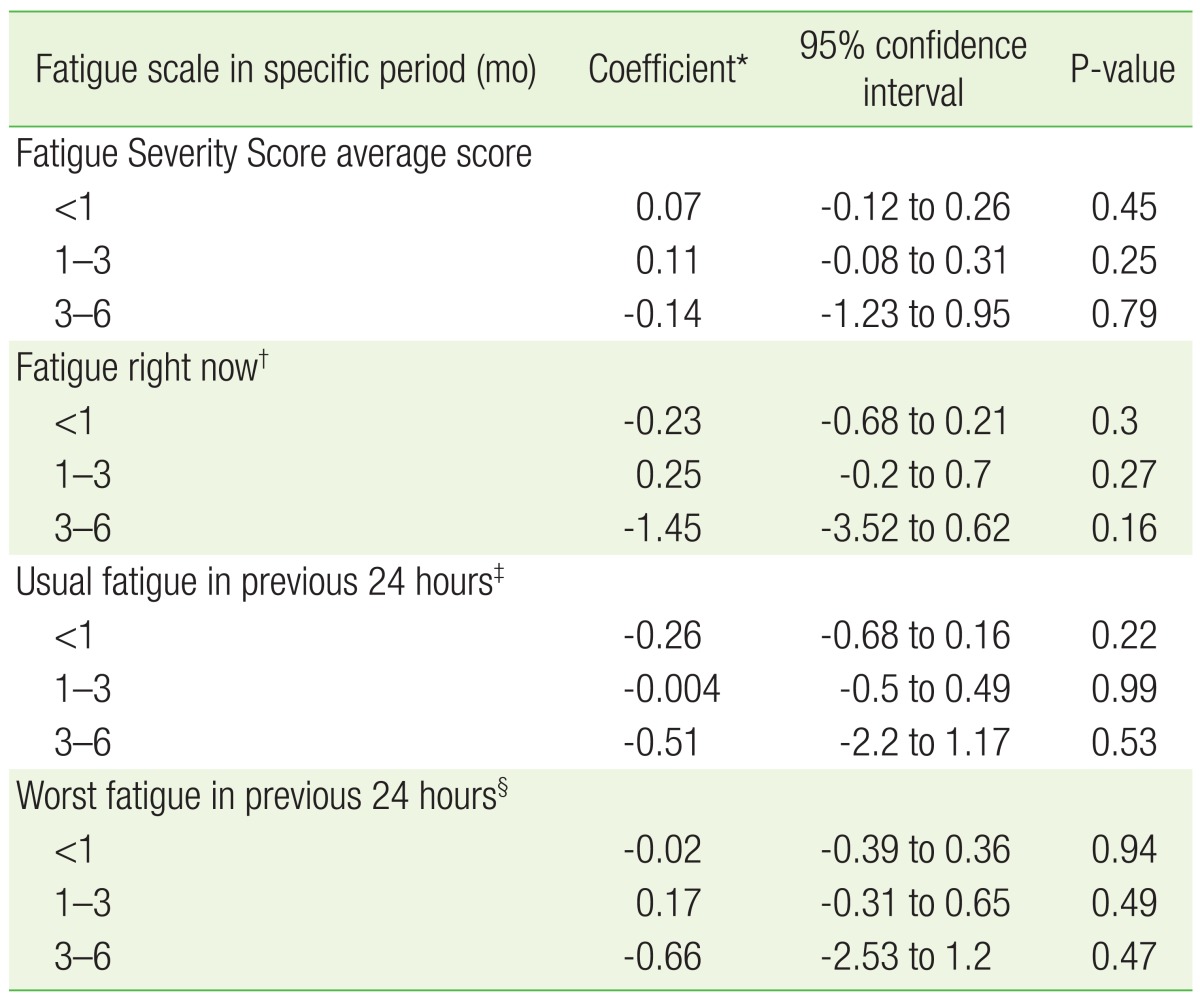1. Kim CH, Shin HC, Won CW. Prevalence of chronic fatigue and chronic fatigue syndrome in Korea: community-based primary care study. J Korean Med Sci 2005;20:529-534. PMID:
16100439.



2. Song JI, Ahn EM, Kim KW, Gwak HK, Park MS, Yoo SH. Factors associated with self-reported fatigue: from Korean National Health and Nutrition Examination Survey 2001. J Korean Acad Fam Med 2007;28:835-844.
3. Dittner AJ, Wessely SC, Brown RG. The assessment of fatigue: a practical guide for clinicians and researchers. J Psychosom Res 2004;56:157-170. PMID:
15016573.


4. Chang SJ, Koh SB, Kang MG, Hyun SJ, Cha BS, Park JK, et al. Correlates of self-rated fatigue in Korean employees. J Prev Med Public Health 2005;38:71-81. PMID:
16312912.

5. Kim JM, Shin MJ, Lee SH, Choi WS, Ock SM, Kim CM, et al. The relationship between autonomous function and fatigue rating in patients with fatigue. J Korean Acad Fam Med 2004;25:52-58.
6. Stasi R, Abriani L, Beccaglia P, Terzoli E, Amadori S. Cancer-related fatigue: evolving concepts in evaluation and treatment. Cancer 2003;98:1786-1801.


8. Ahn GE, Ramsey-Goldman R. Fatigue in systemic lupus erythematosus. Int J Clin Rheumtol 2012;7:217-227. PMID:
22737181.



9. Veauthier C, Radbruch H, Gaede G, Pfueller CF, Dorr J, Bellmann-Strobl J, et al. Fatigue in multiple sclerosis is closely related to sleep disorders: a polysomnographic cross-sectional study. Mult Scler 2011;17:613-622. PMID:
21278050.


10. Lavidor M, Weller A, Babkoff H. How sleep is related to fatigue. Br J Health Psychol 2003;8(Pt 1):95-105.


11. McKercher C, Patton GC, Schmidt MD, Venn AJ, Dwyer T, Sanderson K. Physical activity and depression symptom profiles in young men and women with major depression. Psychosom Med 2013;75:366-374. PMID:
23576769.


12. Chalder T, Neeleman J, Reme SE, Power M, Wessely S. Factors associated with acute fatigue in primary care. Psychol Med 2010;40:1289-1295. PMID:
20102662.


13. Ridsdale L, Hurley M, King M, McCrone P, Donaldson N. The effect of counselling, graded exercise and usual care for people with chronic fatigue in primary care: a randomized trial. Psychol Med 2012;42:2217-2224. PMID:
22370004.



14. Chang KO. The effects of an aquatic exercise program on pain, fatigue, physical fitness, disability in ADL, and psychological variables in women with arthritis. J Korean Acad Community Health Nurs 2009;20:87-95.
15. Lee JI. Effects of walking exercise intensities on fatigue, serum lipids and immune function among middle-aged women. J Korean Acad Nurs 2006;36:94-102.

16. World Health Organization. Global strategy to reduce the harmful use of alcohol. Geneva: World Health Organization; 2010.
17. Chung KI, Song CH. Clinical usefulness of fatigue severity scale for patients with fatigue, and anxiety or depression. J Korean Psychosom Med 2001;9:164-173.
18. Mendoza TR, Wang XS, Cleeland CS, Morrissey M, Johnson BA, Wendt JK, et al. The rapid assessment of fatigue severity in cancer patients: use of the Brief Fatigue Inventory. Cancer 1999;85:1186-1196. PMID:
10091805.


19. Yun YH, Wang XS, Lee JS, Roh JW, Lee CG, Lee WS, et al. Validation study of the Korean version of the brief fatigue inventory. J Pain Symptom Manage 2005;29:165-172. PMID:
15733808.


20. Yun YH, Lee MK, Chun HN, Lee YM, Park SM, Mendoza TR, et al. Fatigue in the general Korean population: application and normative data of the Brief Fatigue Inventory. J Pain Symptom Manage 2008;36:259-267. PMID:
18411013.


21. Ainsworth BE, Haskell WL, Herrmann SD, Meckes N, Bassett DR Jr, Tudor-Locke C, et al. 2011 Compendium of Physical Activities: a second update of codes and MET values. Med Sci Sports Exerc 2011;43:1575-1581. PMID:
21681120.


22. Buysse DJ, Reynolds CF 3rd, Monk TH, Berman SR, Kupfer DJ. The Pittsburgh Sleep Quality Index: a new instrument for psychiatric practice and research. Psychiatry Res 1989;28:193-213. PMID:
2748771.


23. Backhaus J, Junghanns K, Broocks A, Riemann D, Hohagen F. Test-retest reliability and validity of the Pittsburgh Sleep Quality Index in primary insomnia. J Psychosom Res 2002;53:737-740. PMID:
12217446.


24. Kim JS, Kim YS, Lee GY, Park TJ, Lee YH, Kong BK, et al. The standardization of Korean-translated Goldberg's shart screening scale for anxiety and depression. J Korean Acad Fam Med 1997;18:1452-1460.
25. Kim KN, Park JY, Shin TS, Jun KJ, Choi EY, Kim HJ, et al. Degree of stress and stress-related factors by the Korean version of the BEPSI. J Korean Acad Fam Med 1998;19:559-570.
26. Yancey JR, Thomas SM. Chronic fatigue syndrome: diagnosis and treatment. Am Fam Physician 2012;86:741-746. PMID:
23062157.

27. King AC, Oman RF, Brassington GS, Bliwise DL, Haskell WL. Moderate-intensity exercise and self-rated quality of sleep in older adults: a randomized controlled trial. JAMA 1997;277:32-37. PMID:
8980207.


28. LeDuc PA Jr, Caldwell JA Jr, Ruyak PS. The effects of exercise as a countermeasure for fatigue in sleep-deprived aviators. Mil Psychol 2000;12:249-266. PMID:
14983836.


29. Dishman RK, Sallis JF, Orenstein DR. The determinants of physical activity and exercise. Public Health Rep 1985;100:158-171. PMID:
3920714.


30. Yuen HK, Holthaus K, Kamen DL, Sword DO, Breland HL. Using Wii Fit to reduce fatigue among African American women with systemic lupus erythematosus: a pilot study. Lupus 2011;20:1293-1299. PMID:
21700656.














